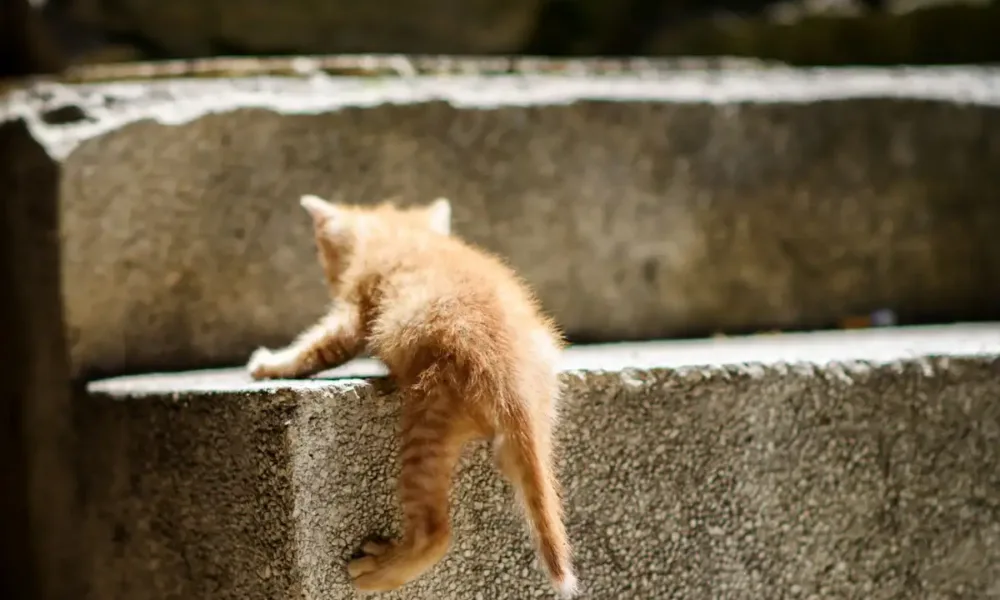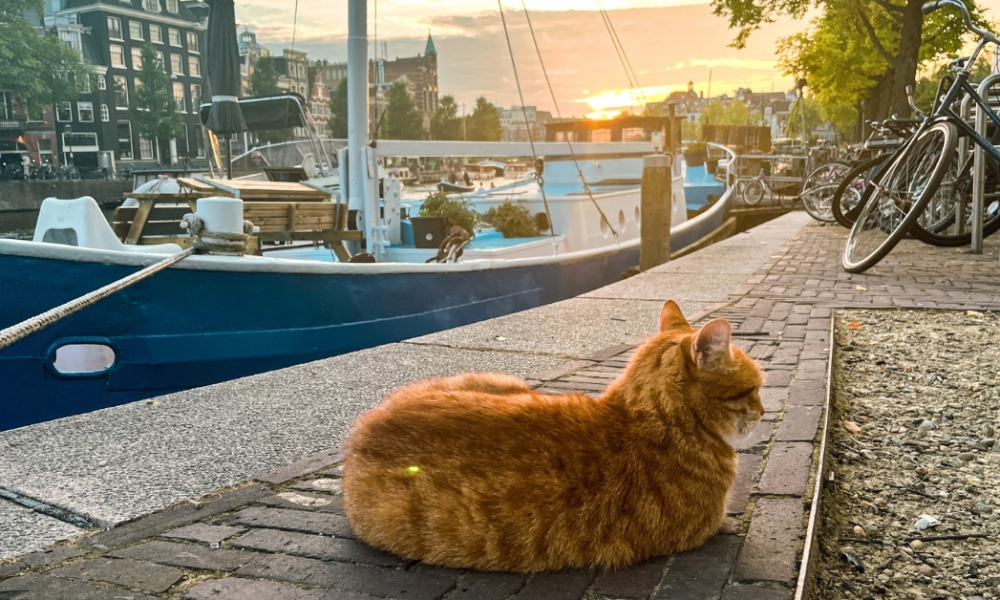Introduction: Small Steps with a Big Impact
When most people think of the Netherlands, images of tulip fields, windmills, bicycles, and canals immediately come to mind. These canals, centuries old and woven through cities like Amsterdam, Utrecht, and Leiden, are both beautiful and practical. They serve as waterways, tourist attractions, and reminders of Dutch ingenuity in managing water. Yet, beneath their charm lies a hidden danger for one of the country’s most beloved animals: cats.
Cats are notoriously curious and adventurous. They love to climb, stalk, and balance along precarious ledges. In canal-heavy cities, this means they often find themselves slipping or leaping into the water, sometimes by accident, sometimes in pursuit of prey like ducks or pigeons. Unlike humans, who can swim or easily climb back onto a boat or dock, cats face a serious challenge: the vertical stone walls of the canals offer no foothold and no easy escape.
Every year, animal rescue services in the Netherlands respond to calls about cats struggling in the water. For many, the story ends happily with rescue. For others, unfortunately, it does not. It was this recurring problem that inspired a remarkable and heartwarming solution—tiny stairs designed specifically for cats, installed along canal walls to help them climb out to safety.
This initiative, though simple, has blossomed into something extraordinary: a symbol of empathy in urban planning and a reminder that even small changes in city design can save lives and warm hearts.
The Problem: Cats and Canals Don’t Mix
A Curious Nature Meets a Tricky Landscape
Cats are natural explorers. Anyone who owns a cat knows how easily they squeeze into tight spaces, leap to improbable heights, and balance on ledges as though they were circus performers. In cities filled with narrow pathways, high walls, and open water, that curiosity can spell trouble.
Unlike dogs, which are usually walked on leashes, many Dutch cats are allowed free rein to explore their neighborhoods. This freedom has cultural roots—the Dutch are known for valuing independence and trust, and their animals often reflect that ethos. Cats are seen not just as pets but as members of the urban ecosystem, often roaming freely through alleyways and gardens.
But in canal cities, this freedom is risky. Cats chasing birds often leap toward ledges or low bridges, only to misjudge the distance. Others slip while walking along mossy stones. Some even deliberately approach the water, not realizing that their exit route will be much more difficult than their entry.
The Scale of the Issue
According to Dutch animal welfare organizations, hundreds of cats fall into canals every year. Many survive thanks to quick interventions by passersby or rescue workers. But because not all incidents are witnessed, the true numbers are likely higher.
Rescue organizations like Dierenambulance Amsterdam frequently share stories of near-misses. Volunteers often use nets or ropes to scoop cats out of the water, but time is of the essence. A panicked cat in water can quickly tire, leading to tragedy. The need for a proactive solution became clear.
The Solution: Tiny Stairs for Big Hearts

The Birth of the Idea
The idea of building tiny stairs—known locally as kattenklimtrappen—emerged from community discussions between pet owners, animal welfare groups, and city planners. Residents began asking: why not give cats a way to save themselves? Instead of waiting for human intervention, the canals could be made safer with small, permanent escape routes.
Design Details
The stairs are designed with cats in mind:
- Size: Small, shallow steps that match the stride of a cat.
- Material: Non-slip surfaces, often metal or treated wood, to prevent slipping in wet conditions.
- Placement: Installed at intervals along canal walls, often near popular walking areas where cats are known to roam.
- Integration: Carefully blended into the historic canal walls so as not to disrupt the aesthetic of UNESCO-protected sites like Amsterdam’s 17th-century canal belt.
Some designs look like miniature ladders angled into the water, while others resemble sloping ramps with grip-friendly textures. The common goal: accessibility for cats, invisibility to casual human observers.
How They Work
If a cat falls into the canal, it swims toward the wall instinctively. Normally, it would find no purchase. With the new stairs, however, it can latch onto the lower rung or ramp and climb up easily. The simplicity of the solution makes it both cost-effective and widely scalable.
Community Involvement and Public Support
One of the most heartwarming aspects of the initiative is the community involvement. Many of the stairs are funded not by governments but by local residents, cat lovers, or crowdfunding campaigns. Some staircases even carry plaques with the names of donors or dedications to beloved pets.
Volunteers and Schools
Volunteers often help with installation, and schools have taken part in awareness campaigns. Children learn about animal welfare, safety, and design, sometimes even sketching their own cat stair prototypes as classroom projects. This educational angle ensures that compassion is passed on to future generations.
Public Reception
The public response has been overwhelmingly positive. Social media posts showcasing cats climbing the stairs often go viral, attracting attention not just in the Netherlands but worldwide. Videos of drenched, shivering cats finding their way back to dry ground have touched millions of viewers, reinforcing the initiative’s value.
Case Studies: Stories from the Canals
Amsterdam’s Canal Cats
In Amsterdam, where over 100 kilometers of canals crisscross the city, cat stairs have been installed in multiple neighborhoods. One famous story involves “Milo,” a ginger tabby known for wandering near the Jordaan district. After slipping into a canal one rainy evening, Milo was seen climbing out on one of the newly installed stairs. His owners credited the initiative with saving his life.
Utrecht’s Community Project
In Utrecht, a community project spearheaded by local residents installed 15 cat stairs along one busy canal section. Within months, local animal services reported a noticeable drop in emergency calls from that area. The project was hailed as a model for other cities.
Global Inspiration: Can Other Cities Follow?
Though the Netherlands’ canal network is unique, other cities face similar challenges where water and animals intersect.
- Venice, Italy: With narrow canals and high stone edges, Venice has its share of pet safety issues. Some residents have begun discussing whether similar structures could help not just cats but also dogs that occasionally slip into the water.
- Bruges, Belgium: Known as the “Venice of the North,” Bruges also has picturesque canals and free-roaming cats. Animal groups there are studying the Dutch model.
- U.S. Riverfront Cities: Cities like San Antonio (Texas), which has a famous riverwalk, and Portland (Oregon), which integrates rivers into urban life, could consider similar pet-friendly adaptations.
By thinking beyond humans, cities can design infrastructures that are more inclusive, sustainable, and compassionate.
Symbolism: What the Cat Stairs Represent
At first glance, the idea of cat stairs may seem trivial. After all, they are small, inexpensive structures serving a very specific need. Yet their symbolism is powerful. They demonstrate that urban design doesn’t have to prioritize only humans—it can also account for the animals that share our spaces.

The initiative reflects core Dutch values:
- Compassion: Caring for animals as part of the community.
- Practicality: Creating simple, functional solutions to real problems.
- Integration: Designing improvements that respect historical architecture.
In a broader sense, the stairs are a reminder that cities are ecosystems, not just concrete landscapes. Every choice in design, no matter how small, affects a web of life.
The Future of Cat-Friendly Cities
Looking ahead, Dutch animal advocates hope to see the stairs become standard features along all major canal routes. Some have proposed integrating smart sensors that alert animal services if a stair is used, helping track incidents and rescue patterns. Others envision educational campaigns where every cat owner learns about the locations of nearby stairs, ensuring that outdoor cats stay within reach of safety.
The idea may also inspire other urban projects—bird-friendly glass to prevent collisions, safe crossings for hedgehogs, or “bee hotels” in city parks. Together, such initiatives could reshape the way we think about urban coexistence.
Conclusion: Small Stairs, Big Lessons
The tiny cat stairs along Dutch canals may not revolutionize transportation, technology, or politics. But they represent something equally important: a culture of kindness woven into daily life.
Each staircase is a quiet act of compassion, a bridge between human ingenuity and animal vulnerability. They remind us that progress isn’t always measured in skyscrapers or megaprojects. Sometimes, it’s measured in the safety of a small animal climbing its way out of danger, back onto solid ground.
In celebrating these stairs, we celebrate a vision of cities that care—not just for their people but for all the lives that inhabit them. And in doing so, we take a step closer to building a world where kindness and practicality walk hand in hand.
